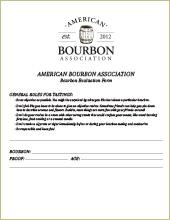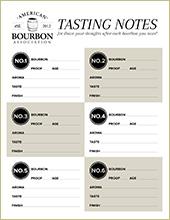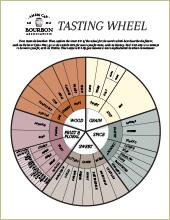Tasting
Become A Connoisseur
Interested in further developing your bourbon palate? Use this guide to help you in writing your own bourbon evaluation, or even hosting a tasting.
When judging the color of a bourbon, start first by carefully choosing the glass you pour it in. A crystal glass will show you the truest color, but avoid the cut crystal glasses that are often made for whiskey. The cuts can distort the hues and mislead your eyes.
While you’re picking out a glass, choose one that is tulip-shaped. The shape will come in handy when you’re testing aroma.
Test the color in a well-lit room, with the glass sitting against a white backdrop. When considering color, swirl the glass around and see how light or dark the bourbon appears. You may notice little tear-like drips that slowly move down the sides of the glass — these are called legs. Clarity is decided by holding the glass up to the light and judging how transparent and bright it is.
To get the best aroma, start with a tulip-shaped glass. Warm the glass in your hands for a moment, swirl the spirits in the glass, then take your first smell. Try not to take in a huge whiff of air; a few short sniffs should do the trick. Then, if you’d like, take a breath of fresh air or sip of water and sniff again.
When whiskey and wine tasters talk about intensity of the aroma, you might hear them describe the drink as "open" or "closed." Think about standing outside your kitchen window while someone is baking a pie inside. If the window is wide open, you’ll be exposed to a multitude of smells from the kitchen: the buttery crumbles, the tart apple filling, maybe even a slightly burnt crust scent. If it’s shut, you might get enough smells to recognize there’s something baking, but you probably wouldn’t know it was apple pie. Keep this analogy in mind when rating the aroma of your bourbon.
The mouth-feel means exactly what it sounds like — how the bourbon makes the inside of your mouth feel. This mostly means texture. At this point, you should have already noted the texture of the bourbon based on its appearance, but testing mouth-feel allows you to see if your eyes told you the same thing about the drink’s texture as your tongue. Using words like "creamy" or "smooth" gives a clearer impression of the texture than you could likely record only by looking.
Your nose can recognize over 32 primary aromas, but your tongue can really only categorize four: The tip of your tongue picks up sweetness, the middle of your tongue picks up sourness, the sides recognize saltiness, and the back of your tongue reports bitterness. When tasting your bourbon, keep in mind that not all of these primary tastes will occur during your sample, but some may occur twice. For example, you could attest that the bourbon starts off sweet, then feels dry in the middle, but ends sweet again as you swallow. Be sure to write all of these sensations down.
Interestingly, the flavors you often recognize in bourbon — smokiness or fruitiness, for example — are not actually caught by your taste buds. These are aromas that are going back through your nasal passages as you taste, creating a perceived flavor on your tongue. To differentiate these more specific flavors from the four Primary Tastes, we’ll call them Overall Flavor. These may be the same as the aromas you noted earlier, or you may actually only be able to "taste" some of the flavors you were able to smell earlier. Or, taste could yield new entirely!
A good bourbon won’t leave you high and dry after you’ve had a taste … it will linger. Thus, the finish is an important part of the process of reviewing your bourbon.
"Finish" describes both the flavor you are left with and the duration of time that flavor stays in your mouth. Experts typically describe a whiskey’s finish as long, medium, or short. Think of "short" as a taste that leaves the senses almost instantly, "long" as one that lingers for several minutes after you swallow.
The finish flavor of a good bourbon will mirror, or complement the aromas and flavors you originally associated with the whiskey when smelling and tasting it. Clearly, if those flavors and aromas were ones you enjoyed, a long pleasant finish is most desired.
Now that you have read how to review each characteristic of the bourbon from your bottle, you're ready to evaluate your bottle.
While the basic taste profile of any given bourbon can be fairly easily described by attributes such as sweetness, spice, fruit, wood or grain notes. More specific taste descriptors can be more entirely subjective. That’s a beautiful thing about bourbon. One person may notice different subtleties than the next person. This is why bourbon reviews occur so often, drinkers like to share and compare their interpretations and experiences with bourbon. While those with seasoned palates may articulate their experience better, there are no “right” or “wrong” tasting notes to describe various bourbons.
Once bourbon is bottled, it no longer ages. The aging of bourbon is a result of chemical reactions that occur when stored in charred oak barrels. While some claim that there can be subtle changes in taste as a result of oxidation over long periods of time, no maturation occurs once bourbon gets bottled.
U.S. federal regulations make no mention of how long a bourbon must be aged, and some bourbons are aged for as little as three months. However, this myth likely originates from the finer distinction given to "straight bourbon," which requires barrels to age for a minimum of two years, and any straight bourbon aged less than four years must state the age on the label.
Federal regulations dictate that bourbon must be aged in new charred oak barrels. Much of the flavor and color is extracted from used barrels during their original use. however, it is common for used bourbon barrels to be reused in aging other whiskeys. Since it's estimated that up to five gallons of bourbon remain trapped in the wood, many barrels are used to age Scotch, which mixes with the remaining bourbon, giving the new spirit much of its flavor.
Tasting Resources
Use these resources to conduct your own bourbon tasting!




